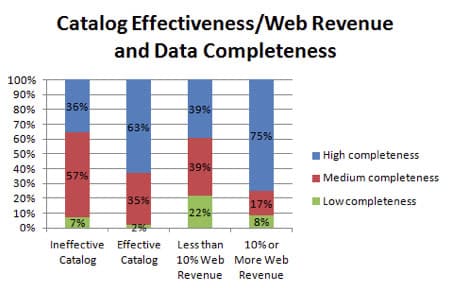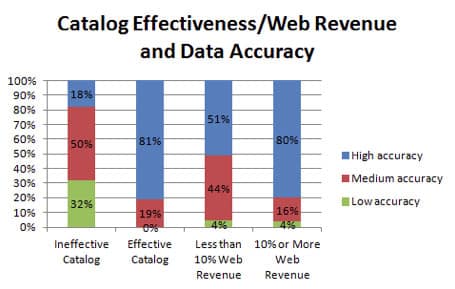Good product data is crucial for any successful distributor catalog or e-commerce website. This includes accurate and complete specifications of products as well as clean photos, related items, and substitute products.
Consider this: Distributors who say they have an effective catalog are nearly twice as likely to have complete data and more than four times as likely to have accurate data than companies with ineffective catalogs, according to a recent survey by MDM and Real Results Marketing. (See Figures 1 and 2.)
What’s more, distributors who generate more than 10 percent of their total revenue from e-commerce are twice as likely to have highly complete data and 60 percent more likely to have accurate data than distributors with smaller e-commerce channels.


The high correlation between good data and successful catalog or e-commerce operations is easy to understand. Once a customer is at a website or browsing in a catalog, good data makes it easier to find and evaluate products to purchase, increasing conversion rate.
Going a step further and including enhanced data such as substitutes and product accessories increases cross-selling which improves average order value. For e-commerce there is an additional benefit of good data: Searchability is improved which, in turn, drives more traffic to the site.
Greg Palmer, director of marketing at industrial distributor Reid Supply Co., said the company has seen benefits from cleaning up its data. “Our website was substandard. Customers couldn’t find what they were looking for due to weak product categorization, corrupt product data, weak product search capabilities and lack of adequate images to represent our product offering accurately,” he said.
The distributor enlisted data services company ByteManagers to clean up the data, adding 40,000 CAD images and improving overall website usability. The result: a 17 percent increase in e-commerce revenue.
Here are some approaches to improving your product data.
Data Scrubbing
The largest function in many data management projects is acquiring data from the supplier and scrubbing it for use in a catalog or website. The objective is accurate product information including product name, product attributes, manufacturer and the location. Among other things, this involves syntax corrections, expanding abbreviations and acronyms, and de-duplication.
Many distributors choose to outsource data scrubbing to a company such as ByteManagers, Enterworks, Sam’s Custom Catalogs or Unilog Content Solutions. The process starts with a test period, where the vendor verifies and validates that the data conversion process has worked with a small set of SKUs. Once that has been demonstrated, larger scale scrubbing and cleansing can commence. After the initial delivery of the entire set of SKUs, the outsource data vendor will often play an ongoing maintenance role to ensure content is accurate and up-to-date.
Typical costs per cleansed SKU range from $1.00 to $2.50 depending on SKU volume and data complexity.
Data Aggregators
An alternative is to work with a third-party data aggregator. The aggregator gathers data from many suppliers and makes it available to many distributors. Although some of the third-party data aggregators such as ThomasNet and Global Spec operate as an online mall for many distributors, other aggregators such as IDEA’s Industry Data Warehouse and IHS provide data that can be used in the distributor’s own catalog or website.
Each of these aggregators provides a single source of information that can be consumed in a variety of formats including XML, flat file, EDI, and so on. IHS boasts detailed information on more than 65 million manufacturer products used directly by engineers and indirectly in distributor catalogs and websites. Unless there are heavy data customization requirements, the advantage to working with aggregators is that data quality is high because it receives scrutiny from more users. The cost is also typically lower.
Discovery
Thanx Media in Chicago has developed a product called Blosm, which is a novel approach for gathering product data that is far less labor-intensive than the traditional data-cleansing approach. As a result, the price per SKU is well below $1. Blosm finds product data on the Web, often from multiple sources including manufacturer data feeds and websites, e-tailers such as Amazon, shopping sites such as Nextag, and from social media sites that include blogs and reviews.
After data has been aggregated and extracted from the different sources, the information is mapped and transformed into a master product database. The mapping and transformation process is automated to suture information together from multiple sources and to arbitrate in the case of conflicts.
This approach provides a very efficient means for creating the initial database and simplifying the maintenance with periodic updates. A data management executive shared the following about Blosm: “It excels at collecting large amounts of data very quickly and in an organized way that was able to be put to use immediately. By using the enriched data that Blosm supplied we lowered expense while increasing efficiency of our employees.”
Easier and Faster
Without good product data, both e-commerce and catalog marketing efforts will suffer. So why haven’t more distributors taken the plunge? Time and cost are most frequently cited as barriers to better data management.
Fortunately, today there are a variety of approaches for getting and maintaining good product data. For those that can afford a custom solution, traditional methods of data scrubbing may be the way to go. But some of these options make clean data attainable even for smaller companies. Improved technology and third-party services make it easier, faster and more affordable.In other words, there’s no excuse not to pursue better product data.
Jonathan Bein, Ph.D. is Managing Partner at Distribution Strategy Group. He’s
developed customer-facing analytics approaches for customer segmentation,
customer lifecycle management, positioning and messaging, pricing and channel strategy for distributors that want to align their sales and marketing resources with how their customers want to shop and buy. If you’re ready to drive real ROI, reach out to Jonathan today at
jbein@distributionstrategy.com.
